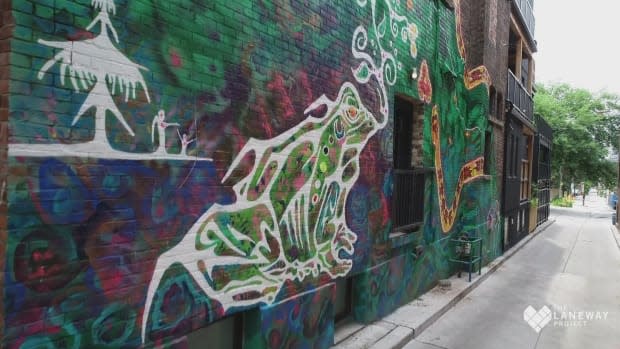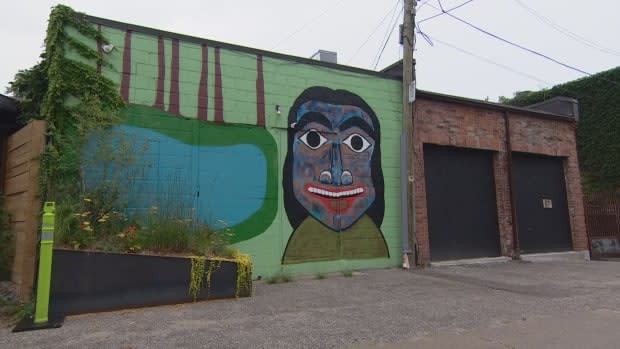Indigenous artists unveil new work in Ontario after months of pandemic isolation

Some Indigenous artists have unveiled new work in Ontario after months of pandemic isolation, saying the discovery of burial sites at Indian residential schools has put a new spotlight on their history and culture.
"Indigenous artists to me are more than just artists," says artist Nyle Miigizi Johnston. "They are our traditional knowledge keepers. They are our song keepers. They paint imagery of historic contexts,of future contexts, of present contexts. To me, they are everything."
One piece unveiled in Toronto on Saturday was the Story-telling Mural in Central Hospital Lane, between Carlton Street and Gerrard Street East, one block east of Sherbourne Street. The mural has been in the works for a year and a half.
The mural, which is a series of paintings, is part of Toronto's first healing corridor.
ArtworxTO: Toronto's Year of Public Art 2021–2022, a year-long celebration of art and community in Toronto, funded the project. The year celebrates the city's public art collection and the artists behind it.
The main mural was painted by Johnston and artist Monica Wickeler. Under their supervision, two smaller murals were painted by five Indigenous youth artists, with the help of Finding Our Power Together, a non-profit organization that works to support Indigenous youth in Toronto to gain access to the resources they seek to achieve their goals.
Johnston said a mural is an art form that is a medium of storytelling and a vehicle for the revitalization of Indigenous language.
"The Ojibwe people have such a long history of painting on rocks. Look at the pictographs found all over the Great Lakes," he said. "To me, that is sacred imagery that is called upon to the direct the people."
Project reclaims laneway with colour, artist says
Added Wickeler: "What we envisioned is reclaiming the laneway with storytelling murals, with colour, with native species, medicinal plants and taking some of the empty concrete spaces and filling them with life and colour, and in that, creating the healing."

The mural depicts a traditional Indigenous story entitled "The Gift of the Jewelweed," which details the discovery of the medicinal properties of the jewelweed by Indigenous people.
"Art is medicine," Johnston said.
A description of the project reads: "The intentions of this project are to help urbanites reconnect with the land, its history, and the people who care for and have tended it so that we may all recognize the potential of reciprocal acts of healing between us and nature."
Healing gardens located along the Central Hospital Lane have been planted with native, traditional medicinal and edible plant species and pay homage to Dr. Oronhyatekha, one of Canada's first licensed medical practitioners and a Mohawk physician and scholar.
Meanwhile, in Stratford, Ont., Tracey Nepinak is starring in a recently launched production of The Rez Sisters at Stratford Festival. The play, which opened on July 23, runs until August 21. The play by Indigenous playwright Tomson Highway portrays seven women from a reserve who go to Toronto in the hopes of winning at the world's largest bingo.
Nepinak, who plays the character of Philomena Moosetail, said people are paying attention to Indigenous stories now more than ever.
"I think, in light of everything that happened over the pandemic... it's really an important time to look at these issues that we've been dealing with for a long, long time. They are still relevant today, maybe even more so now," Nepinak said.
"I think eyes and ears are wide open for listening, for trying to find some understanding about where we come from."
But not all Indigenous artists are thriving. Prior to the pandemic, in May 2019, the Ontario government eliminated a $5 million Indigenous Culture Fund, and lockdowns have made the funding situation worse.
Organization raising funds to help Indigenous artists
Charles C. Smith, executive director of Cultural Pluralism in the Arts Movement Ontario, said the organization has launched a GoFundMe campaign to raise money for artists who are Indigenous, Black and People of Colour and who it hires for its annual events.
The organization describes itself as a IBPOC-led movement of Indigenous and racialized artists engaged in empowering the arts communities of Ontario.
It is planning an event this December. Its theme will be Art in the Time of Healing.
Smith said IBPOC artists are not as well recognized and compensated as white artists.
"For us, it's important to make sure that we can provide opportunities for their work to be seen and for them to talk about their practice, where it comes from, how they are creating their work today and what it means to our arts ecology in Canada," Smith said.

